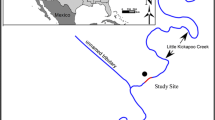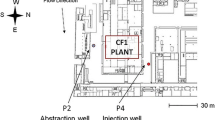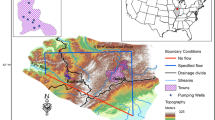Abstract
Travel time is one of the important criteria in the design of managed aquifer recharge systems for securing good drinking water quality. Traditionally, groundwater travel time has been modelled without considering the effect of temperature. In this study, a cross-sectional heat transport model was constructed for the Amsterdam dune filtration system (in the Netherlands) to analyse the effect of temperature on groundwater travel times. A groundwater flow model, a chloride transport model, and a heat transport model were iteratively calibrated with measured groundwater levels, chloride concentrations, and temperature series in order to improve model calibration and reduce model uncertainty. The coupled flow and heat transport model with temperature-dependent density and viscosity provided more accurate estimation of travel times. The results show that seasonal temperature fluctuations in the source water in the infiltration pond cause temperature variations in the shallow groundwater. Viscosity is more sensitive to temperature changes and has a larger effect on groundwater travel times. Groundwater travel time in the shallow sand aquifer increases from 60 days when computed with the traditional groundwater flow model to 73 days in the winter season and 95 days in the summer season when computed with the coupled model. Longer travel time is beneficial for water quality improvement. Thus, it is important to consider the effect of temperature variations on groundwater travel times for the design and operation of managed aquifer recharge systems.
Résumé
Le temps de transit est l’un des critères importants dans la conception des systèmes de gestion de la recharge des aquifères, destinés à garantir une bonne qualité de l’eau potable. Traditionnellement, le temps de transit des eaux souterraines a été modélisé sans prendre en compte l’effet de la température. Dans la présente étude, un modèle de transport de chaleur pour une coupe transversale a été élaboré pour le système de filtration dunaire d’Amsterdam (aux Pays Bas) dans le but d’analyser l’effet de la température sur le temps de transit des eaux souterraines. Un modèle d’écoulement des eaux souterraines, un modèle de transfert des chlorures, et un modèle de transport de chaleur ont été calés selon un mode itératif avec les niveaux piézométriques mesurés, les concentrations en chlorures, et les chroniques de température, dans le but d’améliorer le calage du modèle et de réduire ses incertitudes. Le modèle couplé d’écoulement et de transport de chaleur, associant une densité et une viscosité dépendantes de la température, a fourni une estimation plus exacte des temps de transit. Les résultats montrent que les fluctuations saisonnières de la température de l’eau de recharge dans le bassin d’infiltration génèrent des variations de température dans la nappe d’eau superficielle. La viscosité est plus sensible aux variations de température et a un effet plus fort sur les temps de transit des eaux souterraines. Le temps de transit des eaux souterraines dans l’aquifère superficiel sableux passe de 60 jours quand il est calculé à l’aide d’un modèle d’écoulement souterrain traditionnel à 73 jours en hiver et 95 jours en été quand il est calculé à l’aide d’un modèle couplé. L’allongement du temps de transfert favorise l’amélioration de la qualité de l’eau. Ainsi, il est important de prendre en compte l’effet des variations de la température sur les temps de transit des eaux souterraines pour la conception et la mise en œuvre des systèmes de gestion de la recharge d’un aquifère.
Resumen
El tiempo de tránsito es uno de los criterios importantes en el diseño de los sistemas de recarga de acuíferos gestionados para asegurar una buena calidad del agua potable. Tradicionalmente, el tiempo de tránsito del agua subterránea se ha modelado sin considerar el efecto de la temperatura. En este estudio, se construyó un modelo de transporte de calor transversal para el sistema de filtración de dunas de Ámsterdam (Países Bajos) para analizar el efecto de la temperatura en los tiempos de tránsito del agua subterránea. Un modelo de flujo de agua subterránea, un modelo de transporte de cloruro y un modelo de transporte de calor fueron calibrados iterativamente con niveles medidos de agua subterránea, concentraciones de cloruro y series de temperatura para mejorar la calibración del modelo y reducir la incertidumbre del mismo. El modelo acoplado de transporte de flujo y calor con densidad y viscosidad dependientes de la temperatura proporcionó una estimación más precisa de los tiempos de tránsito. Los resultados muestran que las fluctuaciones estacionales de temperatura en la fuente de agua en la laguna de infiltración causan variaciones de temperatura en el agua subterránea poco profunda. La viscosidad es más sensible a los cambios de temperatura y tiene un mayor efecto en los tiempos de tránsito del agua subterránea. El tiempo de tránsito del agua subterránea en el acuífero de arena poco profunda aumenta de 60 días cuando se calcula con el modelo tradicional de flujo de agua subterránea a 73 días en la temporada de invierno y 95 días en la temporada de verano cuando se calcula con el modelo acoplado. Un tiempo de tránsito más largo es beneficioso para mejorar la calidad del agua. Por lo tanto, es importante considerar el efecto de las variaciones de temperatura en los tiempos de tránsito del agua subterránea para el diseño y operación de sistemas de recarga de acuíferos gestionados.
摘要
运移时间是设计含水层补给技术系统以确保良好饮用水质量的重要标准之一。传统上,地下水的运移时间是在没有考虑温度影响下的模拟所得。在本研究中,为了分析温度对地下水运移时间的影响,建立了阿姆斯特丹沙丘入渗系统(荷兰)的剖面热传输模型。为了改进模型识别并降低模型的不确定性,地下水流模型,氯离子迁移模型和热传输模型用测量的地下水水位,氯化物浓度和温度序列进行依次校准。具有与温度相关的密度和粘度的地下水流动和热传输耦合模型提供了更准确的运移时间估计。结果表明,入渗池中源水的季节性温度波动导致了浅层地下水的温度变化。粘度对温度变化更敏感,对地下水的运移时间影响更大。浅层砂粒含水层的地下水运移时间从传统地下水流模型计算的60天增加到耦合模型计算的冬季73天,夏季95天。较长的运移时间有利于水质改善。因此,考虑温度变化对地下水运移时间对含水层补给技术系统的设计和运行的影响非常重要。
Resumo
O tempo de deslocamento é um dos critérios mais importantes no design de sistemas de recarga de aquíferos gerenciados para assegurar água potável de boa qualidade. Tradicionalmente, o deslocamento das águas subterrâneas foi modelado sem considerar o efeito da temperatura. Nesse estudo, um modelo de transporte de calor transversal foi construído para o sistema de filtragem das dunas de Amsterdam, (nos Países Baixos) para analisar o efeito da temperatura nos tempos de deslocamento das águas subterrâneas. Um modelo de fluxo das águas subterrâneas, um modelo de transporte de cloreto e um modelo de transporte de calor foram interativamente calibrados com os níveis das águas subterrâneas medidos, concentrações de cloreto, e séries de temperaturas para melhorar a calibração e reduzir as incertezas do modelo. O modelo de transporte de calor e fluxo acoplados com a densidade dependente da temperatura e viscosidade trouxeram uma estimativa mais precisa para os tempos de deslocamento. Os resultados demonstram que as flutuações de temperatura sazonais na fonte de água no reservatório de infiltração causam variação de temperatura nas águas subterrâneas rasas. Viscosidade é mais sensível às mudanças de temperatura e tem um amplo efeito nos tempos de deslocamento das águas subterrâneas. O tempo de deslocamento das águas subterrâneas em aquíferos arenosos rasos aumenta de 60 dias quando computado com modelo de fluxo de águas subterrâneas tradicional para 73 dias na estação do inverno e 95 dias na estação do verão quando computado com o modelo acoplado. Tempos de deslocamento mais longos são benéficos para o melhoramento da qualidade da água. Assim, é importante considerar o efeito das variações da temperatura nos tempos de deslocamento das águas subterrâneas para o design e operação dos sistemas de recarga dos aquíferos gerenciados.












Similar content being viewed by others
References
Anderson MP (2005) Heat as a ground water tracer. Ground Water 43:951–968. https://doi.org/10.1111/j.1745-6584.2005.00052.x
Anderson MP, Woessner WW, Hunt RJ (2015) Applied groundwater modeling: simulation of flow and advective transport. Academic, San Diego
Bakker M, Caljé R, Schaars F, van der Made K-J, de Haas S (2015) An active heat tracer experiment to determine groundwater velocities using fiber optic cables installed with direct push equipment. Water Resour Res 51:2760–2772
Bartyzel R (2016) Dating of young groundwater using four anthropogenic trace gases (SF6, SF5CF3, CFC-12 and Halon-1301): methodology and first results. Isot Environ Health Stud 52:393–404. https://doi.org/10.1080/10256016.2015.1135137
Cartwright I, Cendón D, Currell M, Meredith K (2017) A review of radioactive isotopes and other residence time tracers in understanding groundwater recharge: possibilities, challenges, and limitations. J Hydrol 555:797–811
Cirpka OA, Fienen MN, Hofer M, Hoehn E, Tessarini A, Kipfer R, Kitanidis PK (2007) Analyzing bank filtration by deconvoluting time series of electric conductivity. Groundwater 45:318–328
Cook PG, Solomon DK (1997) Recent advances in dating young groundwater: chlorofluorocarbons, and 85Kr. J Hydrol 191:245–265. https://doi.org/10.1016/S0022-1694(96)03051-X
Derx J, Blaschke A, Farnleitner A, Pang L, Blöschl G, Schijven J (2013) Effects of fluctuations in river water level on virus removal by bank filtration and aquifer passage: a scenario analysis. J Contam Hydrol 147:34–44
des Tombe BF, Bakker M, Schaars F, van der Made KJ (2018) Estimating travel time in Bank filtration systems from a numerical model based on DTS measurements. Groundwater 56:288–299
Dillon P (2005) Future management of aquifer recharge. Hydrogeol J 13:313–316. https://doi.org/10.1007/s10040-004-0413-6
Doherty J (2016) PEST Model-independent parameter estimation user manual Part I: PEST, SENSAN and global optimisers. Watermark numerical computing 6
Harbaugh AW (2005) MODFLOW-2005, the US Geological Survey modular ground-water model: the ground-water flow process. US Geological Survey, Reston, VA
Kamps PTWJ (2008) Methoden van kartering van zoet, brak en zout grondwater in de Amsterdamse Waterleidingduinen [Methods for mapping fresh, brackish and saline groundwater inthe Amsterdam Water Supply Dunes]. Internal report, Waternet, Amsterdam, 33 pp
Langevin CD, Thorne Jr DT, Dausman AM, Sukop MC, Guo W (2008) SEAWAT version 4: a computer program for simulation of multi-species solute and heat transport. US Geological Survey, Reston, VA
Lin CY, Greenwald D, Banin A (2003) Temperature dependence of infiltration rate during large scale water recharge into soils. Soil Sci Soc Am J 67:487–493
Loaiciga H (2004) Residence time, groundwater age, and solute output in steady-state groundwater systems. Adv Water Resour 27(7):681–688
Loizeau S, Rossier Y, Gaudet JP, Refloch A, Besnard K, Angulo-Jaramillo R, Lassabatere L (2017) Water infiltration in an aquifer recharge basin affected by temperature and air entrapment. J Hydrol Hydromech 65:222–233. https://doi.org/10.1515/johh-2017-0010
Ma R, Zheng C (2010) Effects of density and viscosity in modeling heat as a groundwater tracer. Groundwater 48:380–389
Markle JM, Schincariol RA (2007) Thermal plume transport from sand and gravel pits–potential thermal impacts on cool water streams. J Hydrol 338:174–195
McGuire KJ, McDonnell JJ (2006) A review and evaluation of catchment transit time modeling. J Hydrol 330:543–563. https://doi.org/10.1016/j.jhydrol.2006.04.020
Moeck C, Radny D, Popp A, Brennwald M, Stoll S, Auckenthaler A, Berg M, Schirmer M (2017) Characterization of a managed aquifer recharge system using multiple tracers. Sci Total Environ 609:701–714. https://doi.org/10.1016/j.scitotenv.2017.07.211
Moel PJ, Verberk JQ, Van Dijk J (2006) Drinking water: principles and practices. World Scientific, Singapore
Molina-Giraldo N, Bayer P, Blum P, Cirpka OA (2011) Propagation of seasonal temperature signals into an aquifer upon bank infiltration. Groundwater 49:491–502
Newman BD, Osenbrück K, Aeschbach-Hertig W (2010) Dating of ‘young’ groundwaters using environmental tracers: advantages, applications, and research needs. Isot Environ Health Stud 46:259–278
Olsthoorn T (2002) Fifty years artificial recharge in the Amsterdam dune area. In: Management of aquifer recharge for sustainability. Netherlands National Committee for the IAHin cooperation with Netherlands Hydrological Society, Delft, The Netherlands
Pollock DW (1994) User’s guide for MODPATH/MODPATH-PLOT, version 3: a particle tracking post-processing package for MODFLOW: the US Geological Survey finite-difference ground-water flow model. US Geol Surv Open-File Rep 94-464
Ronan AD, Prudic DE, Thodal CE, Constantz J (1998) Field study and simulation of diurnal temperature effects on infiltration and variably saturated flow beneath an ephemeral stream. Water Resour Res 34:2137–2153. https://doi.org/10.1029/98wr01572
Schijven J, De Bruin H, Hassanizadeh S, de Roda Husman A (2003) Bacteriophages and clostridium spores as indicator organisms for removal of pathogens by passage through saturated dune sand. Water Res 37:2186–2194
Sheets R, Darner R, Whitteberry B (2002) Lag times of bank filtration at a well field, Cincinnati, Ohio, USA. J Hydrol 266:162–174
Vandenbohede A, Louwyck A, Lebbe L (2009) Conservative solute versus heat transport in porous media during push-pull tests. Transp Porous Media 76:265–287
Zheng C, Wang PP (1999) MT3DMS: a modular three-dimensional multispecies transport model for simulation of advection, dispersion, and chemical reactions of contaminants in groundwater systems: documentation and user’s guide DTIC document. US Army Corps of Engineers, Washington, DC
Acknowledgements
The constructive comments by the associate editor Dr. Barret, the reviewer Dr. Christian Anibas, and an anonymous reviewer helped to improve the manuscript and are gratefully acknowledged.
Author information
Authors and Affiliations
Corresponding author
Rights and permissions
About this article
Cite this article
Liu, S., Zhou, Y., Kamps, P. et al. Effect of temperature variations on the travel time of infiltrating water in the Amsterdam Water Supply Dunes (the Netherlands). Hydrogeol J 27, 2199–2209 (2019). https://doi.org/10.1007/s10040-019-01976-3
Received:
Accepted:
Published:
Issue Date:
DOI: https://doi.org/10.1007/s10040-019-01976-3




